It had been 20 years since I last rolled around Fukuoka. Back then, it was a whirlwind trip – I think I was only there for about a day! So, I was eager to go back when the opportunity came up to return for a seminar on accessibility organized by the prefecture. Not only was I excited to share ideas about accessible tourism, but I was also eager to do a little exploring on my own.
Since I had some downtime, one of the organizers was kind enough to take me to one of the area’s most iconic spots: Dazaifu Tenmangu Shrine. Here is what I found during my wheel-around in Fukuoka.
Getting There and Getting Around
First things first: Fukuoka is easy to navigate. It is the biggest city in Kyushu, yet it feels incredibly compact and manageable.
One of the most amazing things is how close the airport is to the city center. We are talking about a 10-minute subway ride from Fukuoka Airport to the downtown Hakata or Tenjin areas. For anyone used to the hour-long treks from Narita or Kansai International, this is a welcome difference. Fukuoka Airport is large enough to have elevators at the boarding gate, which allow power wheelchair users to take their wheelchair to the boarding gate and get their chair delivered near to the aircraft door upon arrival.
Fukuoka’s main transportation hub is Hakata Station, which is fully accessible and serves as the terminus for the Sanyo Shinkansen line from Honshu (Osaka/Kyoto/Tokyo) and the Kyushu Shinkansen line. From Hakata Station, you can easily access the city subway line that connects to the airport and most major areas.
The subway system is generally excellent. Stations are equipped with elevators and accessible unidsex toilets, and staff are ready with ramps to help you on and off the train when asked. However, a word of caution for those used to the extensive safety features in Tokyo or Osaka: while subway stations have automatic home doors (platform gates) a number of train lines don’t yet have them installed. So, please be careful when waiting on the platform!
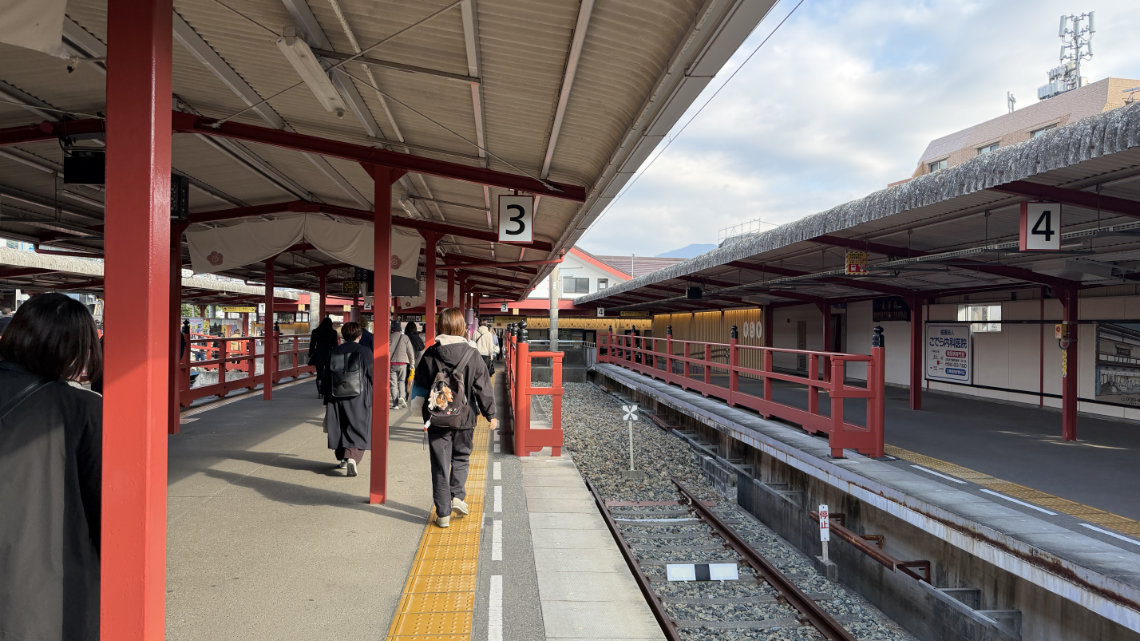
To get to Dazaifu, I took the Nishitetsu train from Fukuoka (Tenjin) Station. Depending on your timing and whether you catch an express, you can get to Dazaifu Station in under an hour. It usually involves a transfer at Futsukaichi Station, but the connections are smooth.
The Sando (Approach to the Shrine)
Arriving at Dazaifu Station, you walk right out onto the sando – the main shopping street leading up to the shrine. This area is bustling with energy and shopping! The street is lined with shops selling crafts and souvenirs (omiyage), and the aroma of grilled mochi is everywhere.
From an accessibility standpoint, the sando is great. The street itself is paved and flat. I was happy to see that the vast majority of shops were completely flat or had a small slope installed at the entrance. The only real barrier might be the crowds – it can get packed, so navigating a wheelchair through the sea of people requires a bit of patience!
Dazaifukan
About halfway up the street, I popped into Dazaifukan, the city-run information center where we met with staff from the city. The entrance has automatic sliding doors and is perfectly flat.
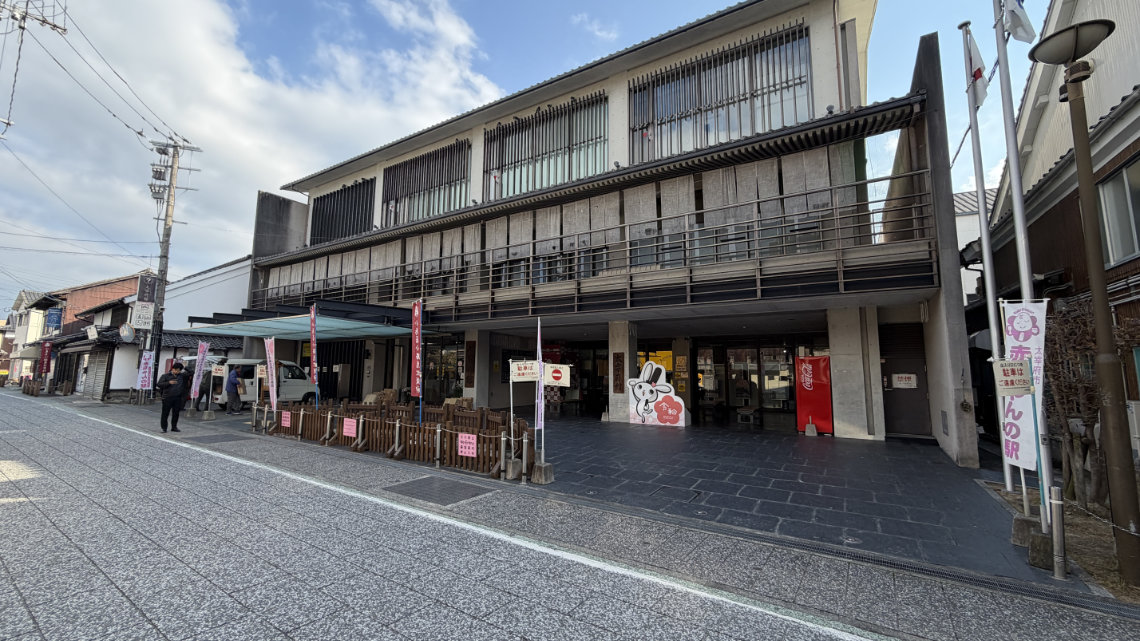
It is definitely worth a stop. Inside, they have a large 3D miniature map of the city that is incredibly detailed – it even marks the locations of accessible toilets! It was such a helpful visual aid to get the lay of the land.
I also saw a row of manual wheelchairs lined up near the reception which are available to borrow, and the best part is that you aren’t restricted to using them inside the building; you can use them to explore the shrine and surrounding area.
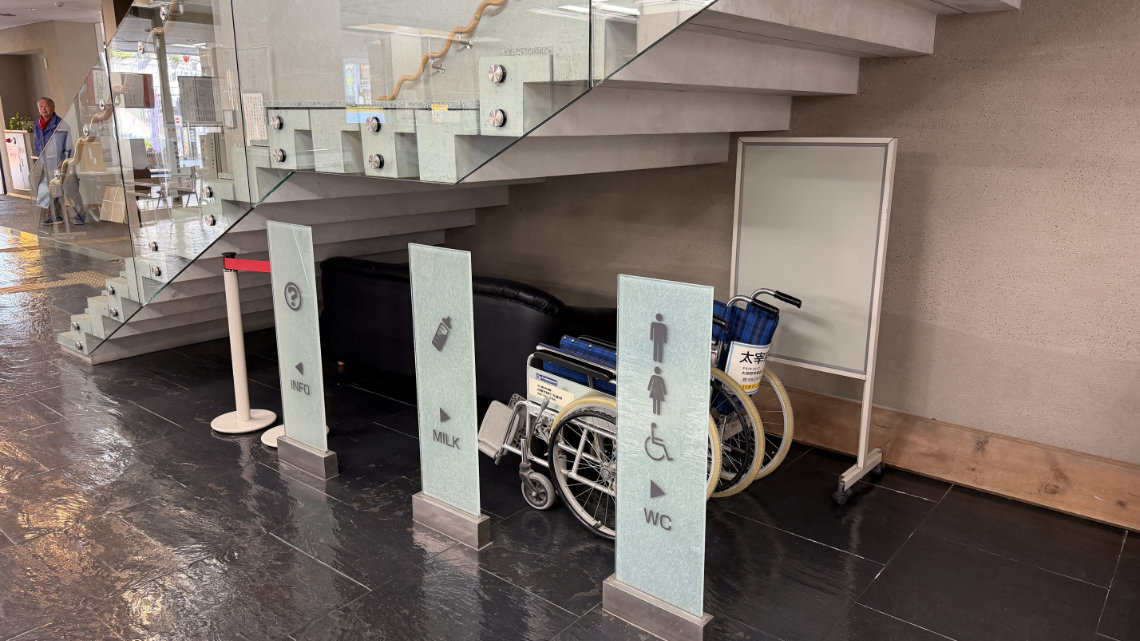
The multipurpose toilet located here is spacious and well-equipped, featuring:
- Ostomate Facilities: A dedicated sink and faucet on the wall next to the toilet.
- Backrest: The toilet has a padded backrest, which provides extra stability and comfort.
- Adult Changing Table: There is a large, fold-down bed (adult changing table), which is a huge relief for families or those who need it.
- Grab Bars: A fixed L-shaped bar on the wall and a flip-up bar on the open side to assist with transfers.
Knowing these facilities are centrally located on the main street takes a lot of the anxiety out of the trip.
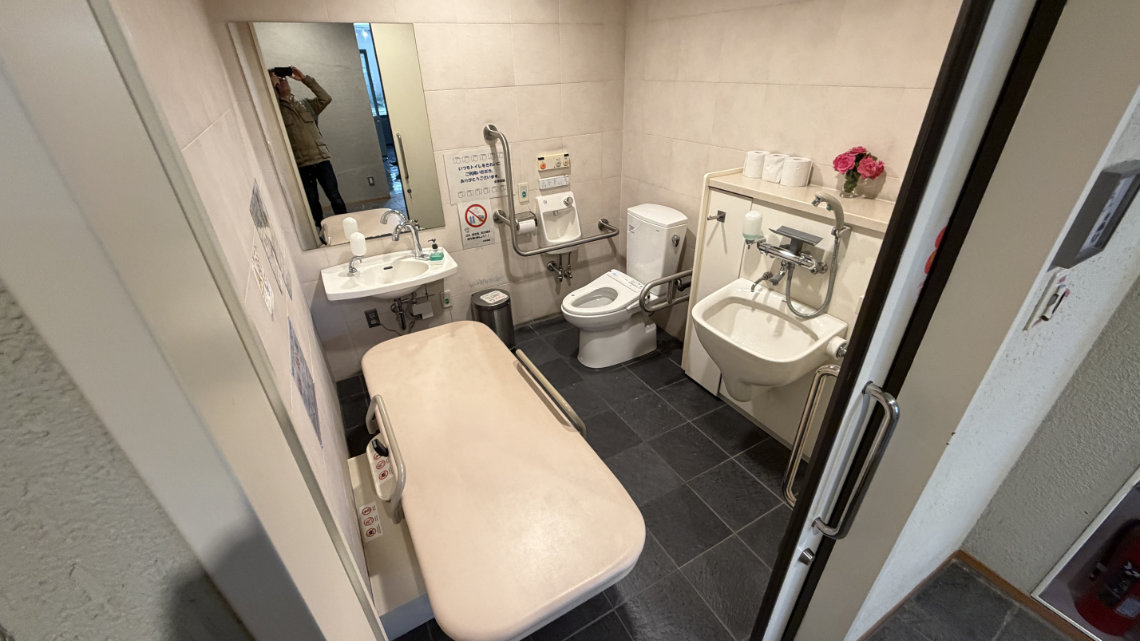
A Coffee Break at Kasanoie
You can’t come to Dazaifu without trying Umegae Mochi, the town’s famous specialty. These are grilled rice cakes filled with sweet red bean paste (anko). I decided to take a much-needed break at Kasanoie (I hadn’t had my morning coffee!), a famous tea house on the Sando.
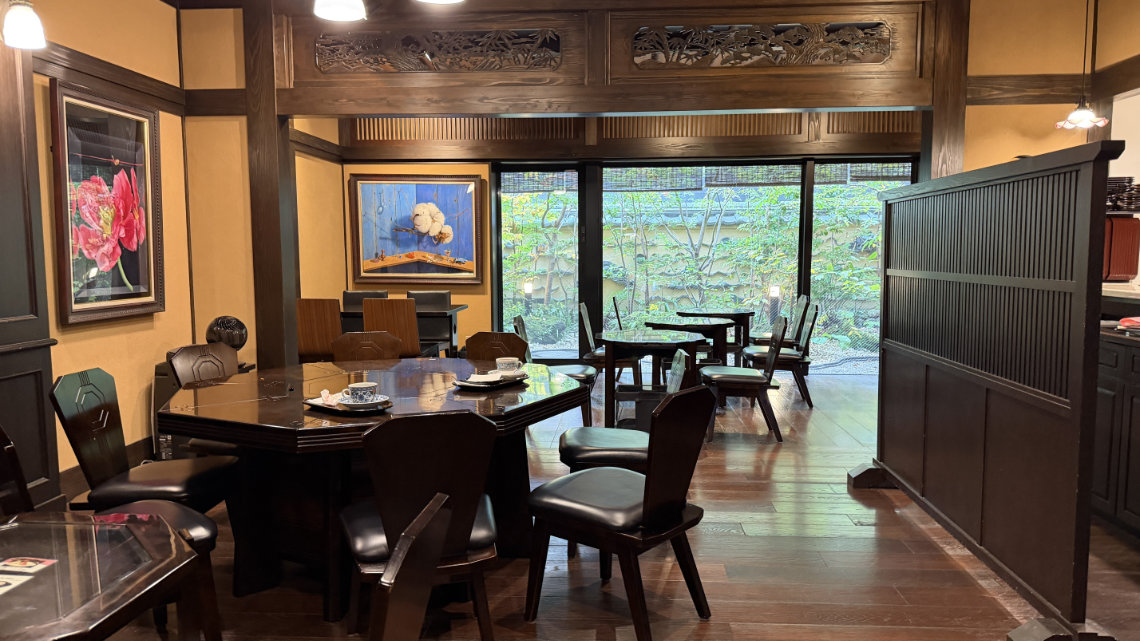
The entrance was smooth, making it easy to roll right in, and I was glad to find a few of the tables were high enough for my wheelchair. I enjoyed the simple, freshly grilled mochi, which had a hot, slightly crispy exterior and a sweet, smooth filling. It goes great with a cup of matcha but again, I’m a coffee guy so, I had coffee.

Dazaifu Tenmangu
At the end of the street, you pass through the main Torii gate and enter the shrine grounds. The scenery is beautiful, but you immediately face the famous Taiko-bashi bridges. These vibrant red bridges are beautiful, but they are steeply arched and have steps, making them impassable for wheelchair users.

However, there is no need to worry as there is a wheelchair route that veers to the right. This path takes you around the edge of the Shinji-ike pond. It was actually a nice, quieter way to enjoy the garden, though there are a few spots with a bit of a steep incline. If you are using a manual chair, you might want a push in these sections.
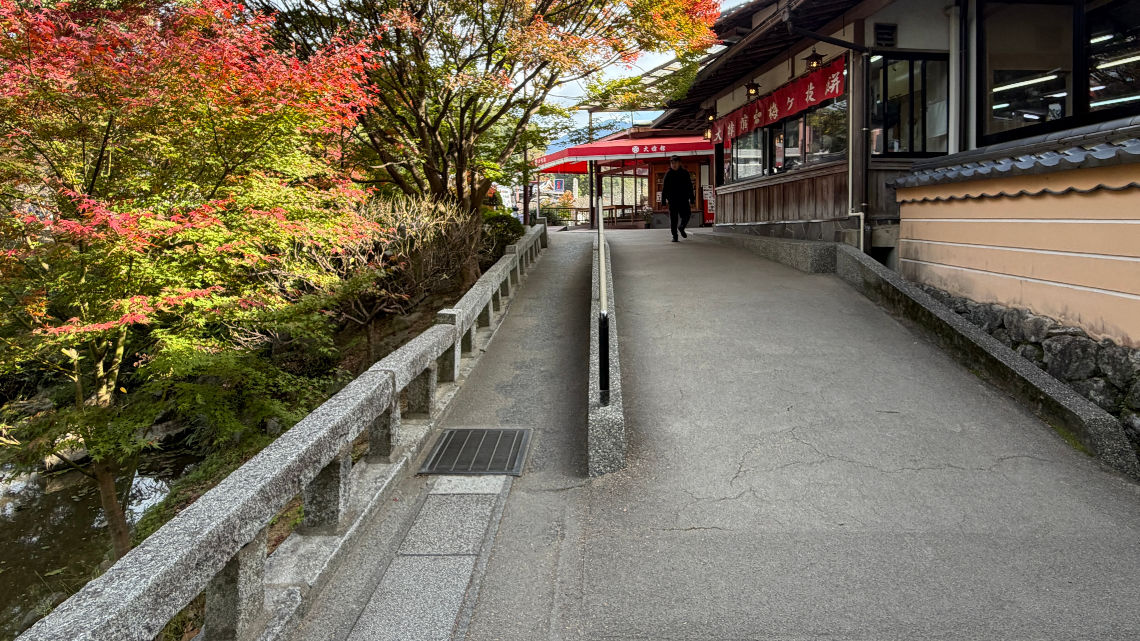
Reaching the main courtyard, I was happy to see the accessibility adaptations. The Ro-mon (two-story gate) usually has high stone thresholds, but wide wooden slopes have been installed to make entering step-free.
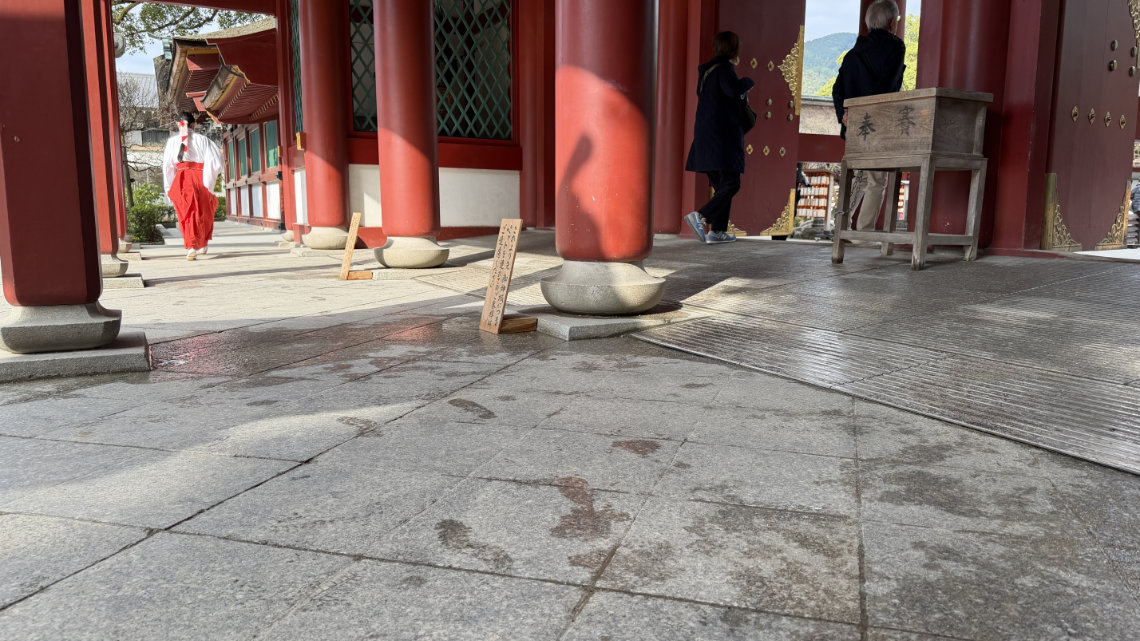
Since the 400-year-old main sanctuary is under renovation (scheduled until around 2026), a modern hall is being used. It is a sight to behold – a sleek, black structure with a “floating forest” of trees literally growing on the curved roof. Best of all, it is built at ground level, allowing you to get right up close.
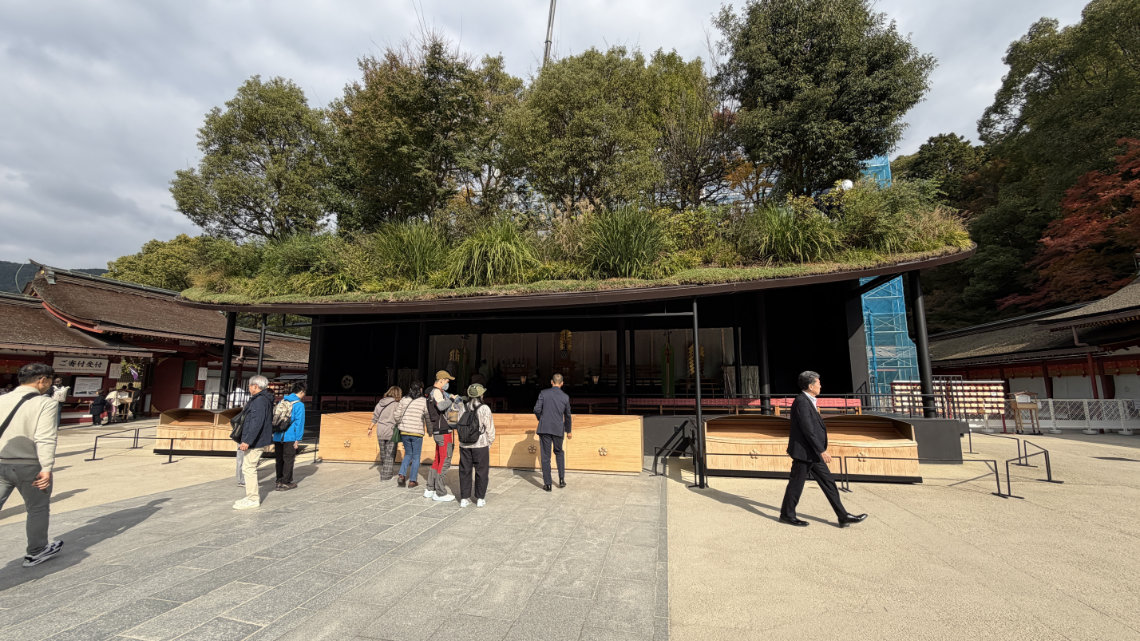
Wheelchairs are available to borrow at the main information center near the entrance to the shrine as are two accessible toilets one in the men’s toilet and one in the women’s toilet. While they are in the other toilets, they are unisex toilets.

Where to Stay: Miyako Hotel Hakata
For this trip, I stayed at the Miyako Hotel Hakata (sometimes listed as Miyako Hotel Fukuoka), located right next to Hakata Station. It was an excellent choice for accessibility, and I wanted to share a few details about the Universal Twin Room I stayed in.
The room itself is spacious and flat. The twin bed layout provides a good amount of turning space in the center of the room. One specific detail I always look for is the bed frame – I was happy to see that these beds are raised on legs, leaving plenty of open clearance underneath for a portable floor hoist. The room is also equipped with a flashing alarm for deaf or hard-of-hearing guests.
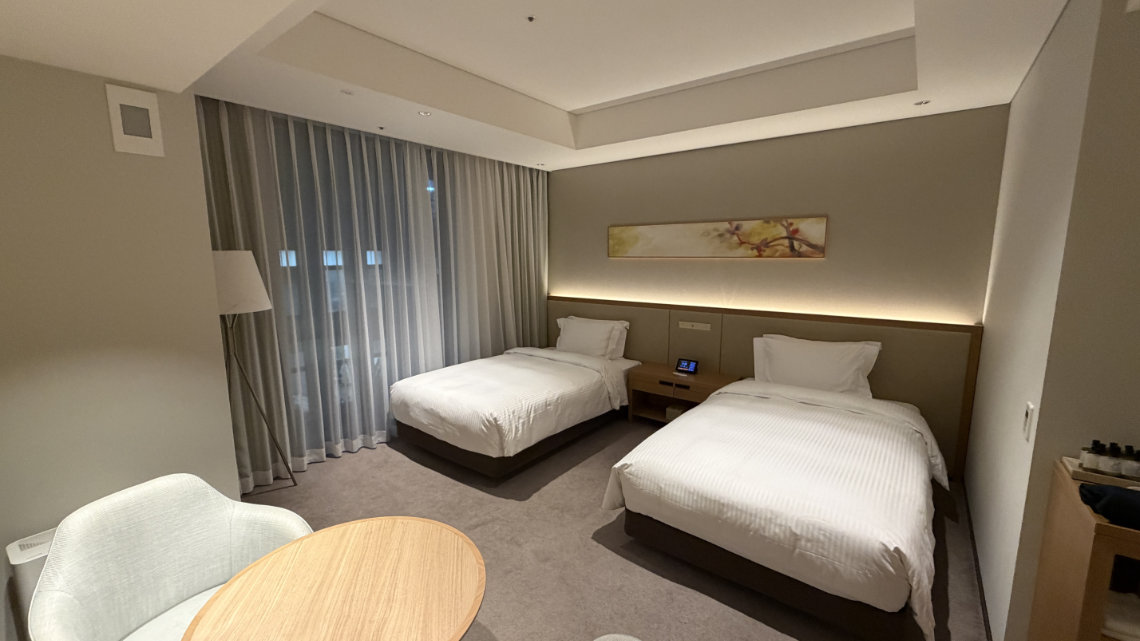
The bathroom layout is a “hybrid” style that I wish more hotels would adopt. It offers a smart compromise between a unit bath and a fully open wet room.
- The Toilet: It is well-equipped with a padded backrest, a fixed L-shaped grab bar on the wall, and a flip-up armrest on the open side.
- The Shower: There is a dedicated washing space next to the bathtub with a proper floor drain and a curtain to avoid getting the toilet area wet. The hotel provided a sturdy shower chair with a backrest, allowing you to wash comfortably without climbing into the tub.

There is also an accessible toilet available in the lobby, which is always handy for a quick stop before heading out for the day.
Looking Forward to Going Back
My brief return to Fukuoka made me wonder why I hadn’t gone back earlier! The food culture is incredible (don’t miss the yatai food stalls!), the nightlife is vibrant, and the history is deep. But more importantly, it’s a city that feels welcoming and surprisingly easy to get around in a wheelchair.
With the convenient airport access, Shinkansen connectivity, and the thoughtfulness of spots like Dazaifukan and the Miyako Hotel, the barrier to entry here is low. I’m already looking forward to my next trip back to explore even more!

Responses